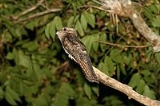
Potoo
Overview
The potoos are a family
, Nyctibiidae of near passerine
bird
s related to the nightjar
s and frogmouth
s. They are sometimes called Poor-me-ones, after their haunting calls. There are seven species in one genus
, Nyctibius, in tropical Central
and South America
.
These are nocturnal insectivore
s which lack the bristles around the mouth found in the true nightjars. They hunt from a perch like a shrike
or flycatcher. During the day they perch upright on tree stumps, camouflage
d to look like part of the stump.
Family (biology)
In biological classification, family is* a taxonomic rank. Other well-known ranks are life, domain, kingdom, phylum, class, order, genus, and species, with family fitting between order and genus. As for the other well-known ranks, there is the option of an immediately lower rank, indicated by the...
, Nyctibiidae of near passerine
Near passerine
Near passerine or higher land-bird assemblage are terms often given to arboreal birds or those most often believed to be related to the true passerines due to ecological similarities; the group corresponds to some extent with the Anomalogonatae of Garrod All near passerines are land birds...
bird
Bird
Birds are feathered, winged, bipedal, endothermic , egg-laying, vertebrate animals. Around 10,000 living species and 188 families makes them the most speciose class of tetrapod vertebrates. They inhabit ecosystems across the globe, from the Arctic to the Antarctic. Extant birds range in size from...
s related to the nightjar
Nightjar
Nightjars are medium-sized nocturnal or crepuscular birds with long wings, short legs and very short bills. They are sometimes referred to as goatsuckers from the mistaken belief that they suck milk from goats . Some New World species are named as nighthawks...
s and frogmouth
Frogmouth
The frogmouths are a group of nocturnal birds related to the nightjars. They are found from India across southern Asia to Australia.They are named for their large flattened hooked bills and huge frog-like gape, which they use to capture insects. Their flight is weak.They rest horizontally on...
s. They are sometimes called Poor-me-ones, after their haunting calls. There are seven species in one genus
Genus
In biology, a genus is a low-level taxonomic rank used in the biological classification of living and fossil organisms, which is an example of definition by genus and differentia...
, Nyctibius, in tropical Central
Central America
Central America is the central geographic region of the Americas. It is the southernmost, isthmian portion of the North American continent, which connects with South America on the southeast. When considered part of the unified continental model, it is considered a subcontinent...
and South America
South America
South America is a continent situated in the Western Hemisphere, mostly in the Southern Hemisphere, with a relatively small portion in the Northern Hemisphere. The continent is also considered a subcontinent of the Americas. It is bordered on the west by the Pacific Ocean and on the north and east...
.
These are nocturnal insectivore
Insectivore
An insectivore is a type of carnivore with a diet that consists chiefly of insects and similar small creatures. An alternate term is entomophage, which also refers to the human practice of eating insects....
s which lack the bristles around the mouth found in the true nightjars. They hunt from a perch like a shrike
Shrike
Shrikes are passerine birds of the family Laniidae. The family is composed of thirty-one species in three genera. The family name, and that of the largest genus, Lanius, is derived from the Latin word for "butcher", and some shrikes were also known as "butcher birds" because of their feeding habits...
or flycatcher. During the day they perch upright on tree stumps, camouflage
Camouflage
Camouflage is a method of concealment that allows an otherwise visible animal, military vehicle, or other object to remain unnoticed, by blending with its environment. Examples include a leopard's spotted coat, the battledress of a modern soldier and a leaf-mimic butterfly...
d to look like part of the stump.
Unanswered Questions

